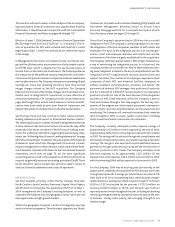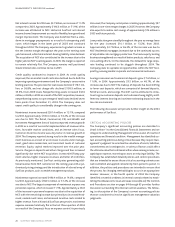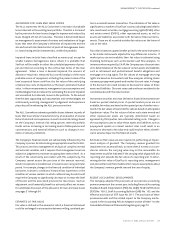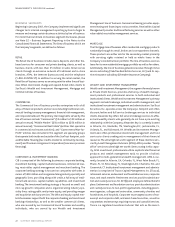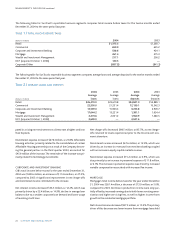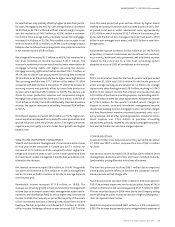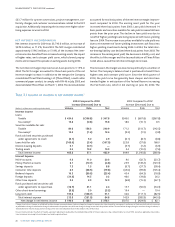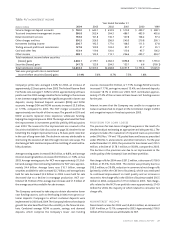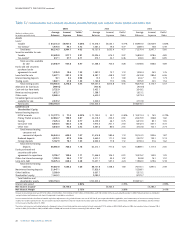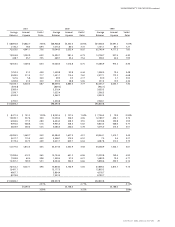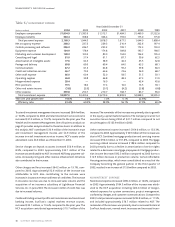SunTrust 2004 Annual Report Download - page 23
Download and view the complete annual report
Please find page 23 of the 2004 SunTrust annual report below. You can navigate through the pages in the report by either clicking on the pages listed below, or by using the keyword search tool below to find specific information within the annual report.
MANAGEMENT’S DISCUSSION continued
SUNTRUST 2004 ANNUAL REPORT 21
ALLOWANCE FOR LOAN AND LEASE LOSSES
The ALLL represents the ALLL Committee’s estimate of probable
losses inherent in the existing loan portfolio. The ALLL is increased
by the provision for loan losses charged to expense and reduced by
loans charged off, net of recoveries. The ALLL is determined based
on management’s assessment of reviews and evaluations of larger
loans that meet the Company’s definition of impairment and the
size and current risk characteristics of pools of homogeneous loans,
i.e., loans having similar characteristics, within the portfolio.
Impaired loans include loans classified as nonaccrual, except for
smaller balance homogeneous loans, where it is probable that
SunTrust will be unable to collect the scheduled payments of princi-
pal and interest according to the contractual terms of the loan
agreement. When a loan is deemed impaired, the amount of
allowance required is measured by a careful analysis of the most
probable source of repayment, including the present value of the
loan’s expected future cash flow, the fair value of the underlying
collateral less costs of disposition, or the loan’s estimated market
value. In these measurements, management uses assumptions and
methodologies that are relevant to estimating the level of impaired
and unrealized, but inherent, losses in the portfolio. To the extent
that the data supporting such assumptions and methodologies are
continuously evolving, management’s judgement and experience
play a key roll in enhancing the ALLL process over time.
The ALLL Committee estimates probable losses inherent in pools of
loans that have similar characteristics by an evaluation of several
factors: historical loss experience, current internal risk ratings based
on the Company’s internal risk rating system, internal portfolio
trends such as increasing or decreasing levels of delinquencies and
concentrations, and external influences such as changes in eco-
nomic or industry conditions.
The Company’s financial results are substantially influenced by the
Company’s process for determining an appropriate level for its ALLL.
This process involves management’s analysis of complex internal
and external variables, and it requires that management exercise
subjective judgment to estimate an appropriate reserve level. As a
result of the uncertainty associated with this subjectivity, the
Company cannot assure the precision of the amount reserved,
should it experience sizeable loan or lease losses in any particular
period. For example, changes in the financial condition of individual
borrowers, economic conditions, historical loss experience, or the
condition of various markets in which collateral may be sold could
require the Company to significantly decrease or increase the level
of the ALLL and the associated provision for loan losses. Such an
adjustment could materially benefit or adversely affect net income.
For additional discussion of the allowance for loan and lease losses
see pages 31 through 34.
ESTIMATES OF FAIR VALUE
Fair value is defined as the amount at which a financial instrument
could be exchanged in a transaction between willing, unrelated par-
ties in a normal business transaction. The estimation of fair value is
significant to a number of SunTrust’s assets, including loans held for
sale, investment securities, mortgage servicing rights (MSRs), other
real estate owned (OREO), other repossessed assets, as well as
assets and liabilities associated with derivative financial instru-
ments. These are all recorded at either fair value or at the lower of
cost or fair value.
Fair value is based on quoted market prices for the same instrument
or for similar instruments adjusted for any differences in terms. If
market prices are not available, then fair value is estimated using
modeling techniques such as discounted cash flow analyses. In
instances where required by GAAP, the Company uses discount rates
in its determination of the fair value of certain assets and liabilities
such as retirement and postretirement benefit obligations and
mortgage servicing rights. The fair values of mortgage servicing
rights are based on discounted cash flow analyses utilizing dealer
consensus prepayment speeds and market discount rates.A change
in the discount rate could increase or decrease the values of those
assets and liabilities. Discount rates used are those considered to be
commensurate with the risks involved.
Investment securities and most derivative financial instruments are
based on quoted market prices. If quoted market prices are not
available, fair values are based on the quoted prices of similar instru-
ments.The fair values of loans held for sale are based on anticipated
liquidation values.The fair values of other real estate owned and
other repossessed assets are typically determined based on
appraisals by third parties, less estimated selling costs. Changes in
the assumptions used to value these assets and liabilities such as
prepayment speeds or interest market rates could result in an
increase or decrease in fair value and could result in either a benefi-
cial or adverse impact on the financial results.
Estimates of fair value are also required in performing an impair-
ment analysis of goodwill. The Company reviews goodwill for
impairment on an annual basis, or more often if events or circum-
stances indicate the carrying value may not be recoverable. An
impairment would be indicated if the carrying value of goodwill of a
reporting unit exceeds the fair value of a reporting unit. In deter-
mining the fair value of SunTrust’s reporting units, management
uses discounted cash flow models which require assumptions about
the Company’s revenue growth rate and the cost of equity.
RECENT ACCOUNTING DEVELOPMENTS
The Company adopted the provisions of several new accounting
pronouncements in the current year, including Financial Accounting
Standards Board Interpretation (FIN) No. 46(R), FASB Staff Position
(FSP) No. 106-2, Staff Accounting Bulletin (SAB) No. 105, and the
effective provisions of EITF Issue No. 03-1. The provisions of these
pronouncements and the related impact to the Company are dis-
cussed in the Accounting Policies Adopted section of Note 1 to the
Consolidated Financial Statements beginning on page 73.










